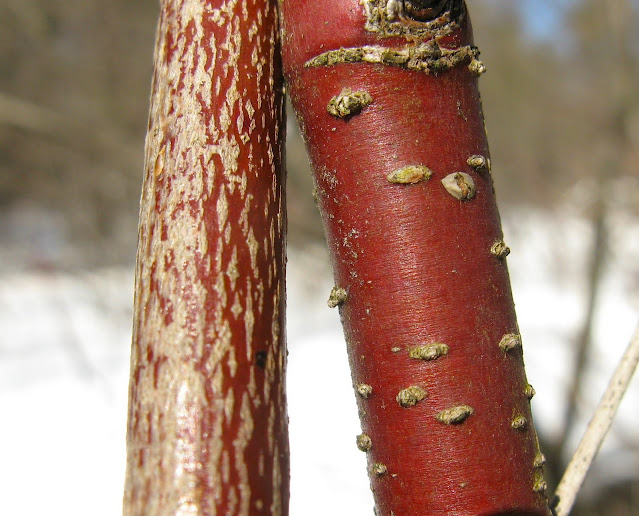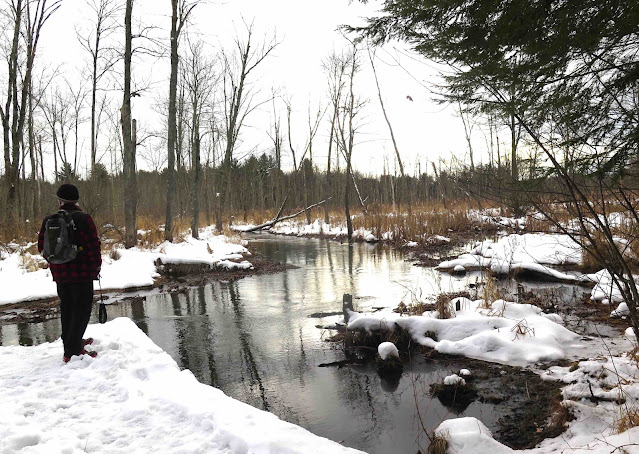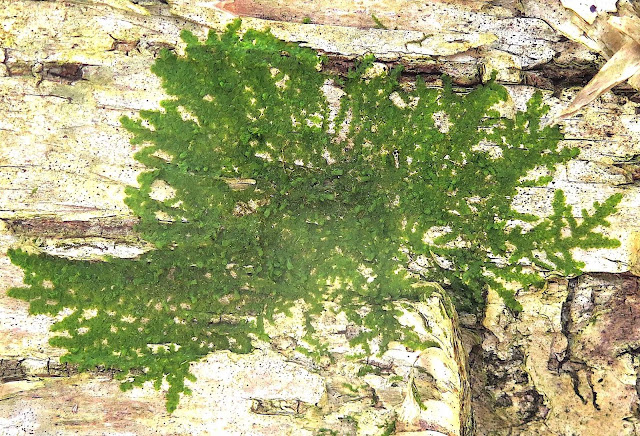Because of a painful eye issue that made me want to keep my eyes closed, I hadn't ventured out except for necessities for more than a week. But lucky for me, just as the pain was subsiding and I could reliably see where I was going, my friends arranged to meet for a walk at Meadowbrook Preserve in Queensbury this week and asked me along. One of the things that's so inviting about this preserve is that it incorporates several different habitats, with well-kept trails that lead through all of them. So we had a chance to find all kinds of natural things to fascinate us.
When we first started out, we crossed a vast open meadow, some of it dry and other parts of it open wetland. The remnants of asters and goldenrods were evidence of the dryer parts, while multitudes of Sensitive Fern spore stalks indicated they'd risen from frozen muck (now covered with snow).
More evidence of a wet habitat along this meadow-crossing trail was provided by two native dogwoods, both of them wetland denizens and both of them bearing red bark. They were even growing so close together we could draw their twigs together to demonstrate the distinctive differences in their barks. The twig on the left, from a Silky Dogwood (
Cornus amomum) bore lengthwise tan lenticels that looked like stripes, while the twig on the right bore rounder, dot-like lenticels, a sure sign that this was the Red Osier Dogwood (
C. sericea).
We soon moved into an extensive forested part of the Meadowbrook Preserve. The snow-covered trail through the woods was so well-packed we needed neither snowshoes nor ice-grippers to safely walk along it. Here, my friends (L-R) Tom, Dana, Noel, and Sue pause while I studied some Red Maple buds that were littering the snow.
I found the maple buds quite puzzling, since they appeared to have bloomed recently (note the anthers), and also because their twigs appeared to have been nipped off and many were lying around on the snow. Could our over-mild winter have compelled our maples to bloom so soon? And has some hungry critter been nipping them off in order to lap at the sap? The mystery remains unsolved!
The woodland trail leads past several other types of wetland, including this swamp with pools of ice-rimmed open water.
We also encountered open cattail marsh with a flowing stream -- called Halfway Brook -- running through it.
A small flock of Mallard Ducks paddled quickly away at our approach. As forecasts call for much colder weather -- up to 20 BELOW predicted later this week! -- I wonder where the ducks will go to find open water.
We did not have to consult our guide books to know that American Beech trees (Fagus grandifolia) thrived in this woods. Just a glance around revealed the presence of many young ones, all holding onto their golden leaves that won't fall until new leaves emerge in the spring.
The wiry bud-studded stems of Beechdrops (
Epifagus virginiana) provided further proof that American Beeches grew nearby. This parasitic plant has no green leaves and so must obtain its nutrients by sucking on the roots of beech trees.
Yellow Birch (Betula alleghaniensis) also abounds in this woods, immediately recognizable by its gleaming golden bark with small shredded curls. When we spotted this arching branch of one, my friends couldn't resist appearing to hold it up for the picture-taking. I sure am glad I have such fun-loving pals!
See how beautifully this Yellow Birch bark gleams as if gilded with gold leaf! And see also the lovely little patch of lacy green, so beautifully arrayed against the gleaming gold.
Here's a closer look at that lacy green growth, with its tiny round overlapping leaves that sprawl across the yellow treebark. Both Sue and Tom immediately recognized this arboreal liverwort as Radula complanata, also known as Flat-leaved Scalewort. I am very familiar with the dark-colored Frullania liverworts that decorate many woodland trees, but I had never noticed this vividly green growth before. So beautiful!
Here was another tree with yellowish bark, American Basswood (Tilia americana), this tree displaying the signature lines of holes created by the Yellow-bellied Sapsucker as it drills for sap.
And of course, we found fungi! A winter woodland walk would be so much less delightful without them. Even if I didn't know what to call it, I still marveled at the beauty of these golden overlapping caps, crowned with snow. The caps seemed too thin to be Turkey Tail and not wavy enough to be Stereum.
Each golden cap had a cream-colored fertile-surface covered with teeny-tiny circular pores. That should have been a clue for me, but I confess I'm still stumped!
At least I wasn't stumped by this small stump-full of genuine Turkey Tail fungus (Trametes versicolor), with its distinctive zones of alternating colors and textures.
I confess I have been confused about this next fungus, most likely the Amber Jelly Fungus (Excidia recisa), mistaking it for Wood Ear Fungus (Auricularia sp.), which does look quite similar. In fact, the two species look so much alike, I may still be mistaken about this ID. There are several articles I can read on Google about how to tell the two apart, but accuracy depends on having the species in hand. And all I have right now is this photograph. Very cool looking fungus, whichever one it is. And one that we can depend on finding in winter.
Last fungus, and another one that conspires to confuse us, especially when coated with green algae to mask its normal coloration. But the distinctive purple coloration of Violet-toothed Polypore (
Trichaptum biforme) is also missing this time of year, age having rendered the caps an undistinguishable beige vaguely striped with light brown. So why am I assuming this fungus is the Violet-toothed Polypore?
I usually depend on the rusty color of Purple-toothed Polypore's fertile surface, as well as the tiny teeth, not pores, that cover it. Well, that rusty color has remained unchanged, but its tiny teeth sure look different. Having long ago expelled their spores, the teeth have kind of exploded open, so they form a maze-like jumbled appearance.
At least, I think that's what's happened here. Sigh! Winter fungi can be hard!



















An intteresting few pictures of trees and fungi I could relate to. I like that deep knuckly purple one, whichever name it is.
ReplyDeleteIf you zoom in and look really close at the tops of the middle two Violet-toothed Polypores, you will see what looks like tiny black stubble. That “stubble” is the fungus Phaeocalicium polyporaeum, which is a parasite on Violet-toothed Polypore.
ReplyDeleteGlad to see you also have problems identifying fungi, many of them are a mystery to me.
ReplyDeleteI loved your photo of the Beechdrops (Epifagus virginiana) Jackie! I was previously unaware of this parasitic plant but will be on the lookout for it now! Thank you!
ReplyDelete